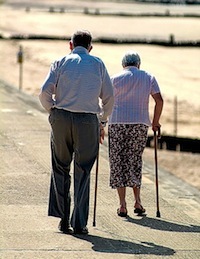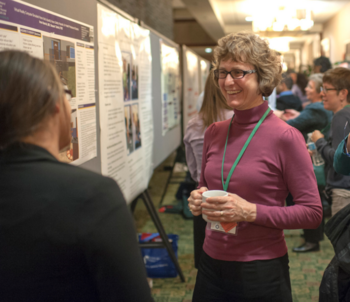Innovative program reduces falls, increases quality of elderly life
When Loretta, a 78-year-old central Wisconsin woman, became unable to sit on her couch because of her fear of not being able to stand back up, she knew she needed help. She didn’t want to be a burden to her husband, who was already worried about her falling, so Loretta called her local doctor to find a solution.

Falls are the leading cause of injury for the elderly; more than half of all 80-year-olds fall each year.
Irene Hamrick, a physician and researcher in the University of Wisconsin–Madison School of Medicine and Public Health’s Department of Family Medicine, has provided that solution for many elderly patients with a fear of immobility or falls by implementing the Lifestyle and Functional Exercise program (LiFE), an Australian fall-prevention program she adapted for use here. After a referral from her physician, Loretta was able to join.
LiFE, which is being piloted in Wausau with plans to expand statewide, is an in-home program for patients 70 years or older that integrates exercises into daily activities, such as balancing on one leg while brushing their teeth. It is based on several balance and strength exercise programs that have been shown to reduce falls, but integrates them to provide the best benefits in the shortest amount of time.
“There are several programs that reduce fall risk, but I was most intrigued by LiFE because it integrates exercise into daily activities,” Hamrick says. “Trying LiFE myself, I identified some balance weaknesses … and improved them, as well as increased my bicycling speed by 20 percent.”
Falls are the leading cause of injury for the elderly; more than half of all 80-year-olds fall each year. Wisconsin’s death rates for elderly falls are twice the national average, making it a serious health issue.
The program represents an idea shift for therapists who typically tell patients to avoid daily activities that may be challenging for balance. The LiFE program is taught in the home, and the goal of the U.S. program will be to match and disseminate the success of the Australian version.

UW researcher Irene Hamrick says she was intrigued by LiFE because it integrates exercise into daily activities.
LiFE partners with the Wisconsin Institute for Healthy Aging and Aspirus health system in Wausau to identify patients in need of the program and to train caregivers in the exercise methods. Hamrick says that one of the program’s primary goals is to be able to provide access across the state.
“Dr. [Jane] Mahoney, the director of the Wisconsin Institute for Healthy Aging, has experience with disseminating falls programs,” says Hamrick. “With her help, we are rolling out LiFE across Wisconsin.”
In the Australian study, patients in the LiFE program showed a 31 percent fall reduction, greater adherence and better functional and activity outcomes compared to a group of patients receiving only strength and balance exercises. Dr. Hamrick has high hopes for the success of the program for Wisconsin residents.
“We are very excited with the success we have seen so far,” Hamrick says. “Patients really want to do the program, and we have not had anyone drop out.”
Loretta is one of the many patients who have noticed the benefits of the program first-hand.
“I now exercise daily because it is part of my everyday living,” says Loretta. “I could see the progress and then challenged myself if I could do more.”
Subscribe to Wisconsin Ideas
Want more stories of the Wisconsin Idea in action? Sign-up for our monthly e-newsletter highlighting how Badgers are taking their education and research beyond the boundaries of the classroom to improve lives.




